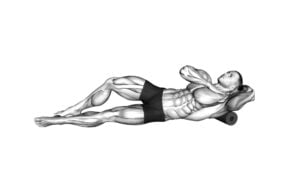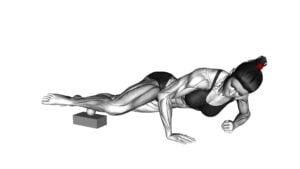Roll Posterior Shoulder Lying on Floor (female) – Video Exercise Guide & Tips

Are you looking for a challenging exercise to target your posterior shoulder muscles? Look no further!
Watch This Exercise Video
In this video exercise guide, we will walk you through the roll posterior shoulder exercise while lying on the floor. By following proper technique and incorporating key tips, you can maximize shoulder engagement and see great results.
Whether you're a beginner or advanced, we also provide variations to suit your fitness level.
Let's get started!
Key Takeaways
- Improved shoulder mobility and strength
- Alleviates tension and tightness
- Promotes better posture
- Increased range of motion and flexibility
Benefits of the Roll Posterior Shoulder Exercise
You will experience improved shoulder mobility and strength from performing the Roll Posterior Shoulder exercise. This exercise specifically targets the muscles in the back of your shoulders, helping to increase the range of motion and flexibility in that area. By engaging these muscles, you can alleviate tension and tightness in the shoulders, which can be especially beneficial if you spend a lot of time sitting at a desk or engaging in activities that require forward shoulder movement.
In addition to improved shoulder mobility, the Roll Posterior Shoulder exercise can also contribute to better posture. When the muscles in the back of your shoulders are strong and flexible, they can help to pull your shoulders back, promoting a more upright and aligned posture. This can have a positive impact on your overall body alignment, reducing the risk of developing poor posture-related issues such as rounded shoulders or a forward head position.
Now that you understand the benefits of the Roll Posterior Shoulder exercise, it's essential to learn the proper technique for lying on the floor to perform this exercise effectively.
Proper Technique for Lying on the Floor
To achieve proper technique for lying on the floor, position yourself on your back with your legs extended and arms by your sides. This floor position provides a stable foundation for the exercise and allows for optimal body alignment. Start by lying flat on the floor, ensuring that your spine is in a neutral position. Your head should be aligned with your spine, and your chin should be slightly tucked. Keep your shoulders relaxed and away from your ears.
Next, extend your legs fully with your feet pointing upwards. Make sure your knees are straight and not locked. Keep your feet hip-width apart to maintain stability. Your arms should be resting comfortably by your sides, palms facing down.
Maintaining proper body alignment is crucial for this exercise. Ensure that your shoulders, hips, and ankles are all in line. Avoid any excessive arching or rounding of your back. Engage your core muscles throughout the exercise to provide stability and support to your spine.
Key Tips for Maximizing Shoulder Engagement
To maximize shoulder engagement during the Roll Posterior Shoulder exercise, focus on maintaining proper form and activating the targeted muscle groups. Proper shoulder engagement is essential for maximizing the benefits of this exercise and reducing the risk of injury.
First, prioritize shoulder mobility. Before starting the exercise, warm up your shoulders with dynamic stretches and mobility exercises. This will help improve your range of motion and prepare your shoulder joints for the movement. Additionally, ensure that you're performing the exercise on a stable surface to promote proper shoulder alignment and prevent unnecessary strain.
Next, concentrate on shoulder stability. Engage your shoulder blades by retracting and depressing them throughout the exercise. This will help stabilize your shoulders and improve the effectiveness of the movement. Focus on squeezing your shoulder blades together as you roll your posterior shoulder along the floor. This activation will ensure that the targeted muscle groups are properly engaged and working effectively.
Remember to maintain control and avoid rushing through the exercise. Slow and controlled movements will enable you to focus on shoulder engagement and reduce the risk of compensatory movements.
Variations to Increase or Decrease Difficulty
Try modifying the range of motion to increase or decrease the difficulty of the Roll Posterior Shoulder exercise. By adjusting the range, you can target different muscles and challenge yourself in new ways.
To increase the difficulty, start by increasing the range of motion. Instead of rolling just the posterior shoulder, try rolling the entire shoulder girdle. This will engage more muscles and require greater stability. You can also increase the difficulty by adding resistance. Hold a dumbbell or resistance band while performing the roll to add an extra challenge to your muscles.
On the other hand, if you want to decrease the difficulty, you can decrease the range of motion. Instead of rolling all the way onto your side, stop halfway and roll back. This will still engage the posterior shoulder, but with less intensity. You can also decrease the difficulty by using less resistance or no resistance at all.
Remember to listen to your body and choose the variations that feel challenging but manageable for you.
Now that you're familiar with the variations to increase or decrease difficulty, let's move on to the next section about common mistakes to avoid during the exercise.
Common Mistakes to Avoid During the Exercise
Avoid these common mistakes when performing the Roll Posterior Shoulder exercise to ensure proper form and maximize the benefits. Maintaining proper form is crucial for targeting the posterior shoulder effectively and preventing injuries.
One common mistake is using too much momentum during the exercise. This can happen when you roll your shoulder too quickly or forcefully, relying on the momentum rather than the muscles to perform the movement. To avoid this, focus on slow and controlled movements, allowing your muscles to fully engage throughout the exercise.
Another mistake to avoid is lifting your upper body off the floor during the roll. This can lead to excessive strain on the neck and lower back. Keep your upper body firmly planted on the floor throughout the exercise, using your shoulder muscles to initiate the roll.
Improper positioning of the shoulder can also hinder the effectiveness of the exercise. Make sure your shoulder is properly aligned with your elbow and wrist to maintain proper form and engage the targeted muscles. Avoid allowing your shoulder to collapse or roll inward during the movement.
Lastly, avoid using weights that are too heavy for your fitness level. Using excessive weight can compromise your form and increase the risk of injury. Start with lighter weights and gradually increase the resistance as your strength improves.
Frequently Asked Questions
How Many Sets and Reps Should I Do for the Roll Posterior Shoulder Exercise?
To determine how many sets and reps you should do for the roll posterior shoulder exercise, it's important to consider your fitness level and any shoulder injury modifications you may need. This exercise targets the posterior shoulder muscles, improving strength and stability.
Start with 2-3 sets of 8-12 reps, gradually increasing as you get stronger. Remember to maintain proper form and listen to your body to prevent any further injury.
Can I Perform This Exercise if I Have a Shoulder Injury?
If you have a shoulder injury, it's important to modify the roll posterior shoulder exercise to avoid further damage.
Consult with a healthcare professional or a certified trainer who can recommend alternative exercises that are suitable for shoulder rehabilitation.
It's crucial to prioritize your recovery and ensure that you're not putting unnecessary strain on your injured shoulder.
Is It Necessary to Warm up Before Doing the Roll Posterior Shoulder Exercise?
It is recommended to warm up before performing the roll posterior shoulder exercise to prepare your muscles and reduce the risk of injury.
Incorporating this exercise into your workout routine can provide several benefits, such as improving shoulder mobility and strengthening the posterior shoulder muscles.
For beginners, modifications can be made to safely perform the exercise, such as using lighter weights or starting with a smaller range of motion.
Remember to always listen to your body and consult a professional if you have any concerns.
How Long Should I Hold Each Repetition of the Exercise?
When performing the roll posterior shoulder exercise, it's important to know how long to hold each repetition. Holding each repetition for about 2-3 seconds is a good starting point. However, as you progress and get stronger, you can increase the hold time to 5-10 seconds.
Remember, the goal is to challenge your muscles without straining them. Incorporating this exercise into your routine can improve shoulder mobility and strengthen the muscles of your posterior shoulder.
For beginners, it's always a good idea to consult with a fitness professional or modify the exercise to suit your needs.
Can I Use a Resistance Band or Weights to Make the Exercise More Challenging?
To make the exercise more challenging, you can incorporate resistance band modifications or use weights as alternative equipment options. By adding resistance, you increase the load on your posterior shoulder muscles, making them work harder. This can help to further strengthen and tone those muscles.
However, it's important to start with lighter weights or a lower resistance band and gradually increase the intensity as your strength improves. Always consult with a fitness professional for guidance on proper technique and progression.
Conclusion
In conclusion, the roll posterior shoulder exercise is a great way to target and strengthen the muscles in the back of the shoulder. By lying on the floor and using proper technique, you can effectively engage your shoulders and improve their mobility and stability.
Remember to follow the key tips for maximizing shoulder engagement and be cautious of common mistakes.
With variations to increase or decrease difficulty, this exercise can be tailored to your fitness level.
Start incorporating the roll posterior shoulder exercise into your workout routine for stronger and healthier shoulders.

Author
Years ago, the spark of my life’s passion ignited in my mind the moment I stepped into the local gym for the first time. The inaugural bead of perspiration, the initial endeavor, the very first surge of endorphins, and a sense of pride that washed over me post-workout marked the beginning of my deep-seated interest in strength sports, fitness, and sports nutrition. This very curiosity blossomed rapidly into a profound fascination, propelling me to earn a Master’s degree in Physical Education from the Academy of Physical Education in Krakow, followed by a Sports Manager diploma from the Jagiellonian University. My journey of growth led me to gain more specialized qualifications, such as being a certified personal trainer with a focus on sports dietetics, a lifeguard, and an instructor for wellness and corrective gymnastics. Theoretical knowledge paired seamlessly with practical experience, reinforcing my belief that the transformation of individuals under my guidance was also a reflection of my personal growth. This belief holds true even today. Each day, I strive to push the boundaries and explore new realms. These realms gently elevate me to greater heights. The unique combination of passion for my field and the continuous quest for growth fuels my drive to break new ground.







